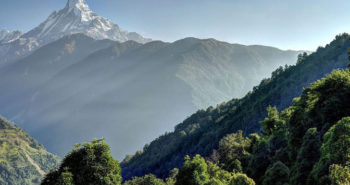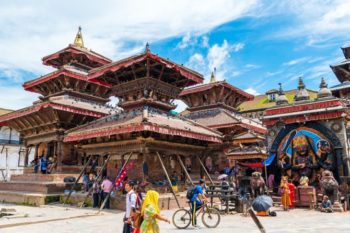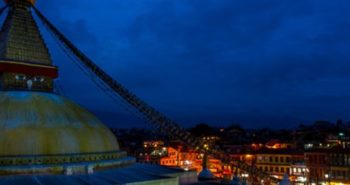Altitude Variation in Langtang Trek
On Langtang trek, your journey will start from Kathmandu, 1400m and you ascend in the Langtang region to the highest point at Kang Jin Gompa, 3900m. That means you will experience 2460m of the altitude variation in Langtang trek starting from Kathmandu to Kang Jin Gompa.
To cover this altitude variation in the Langtang region, you need to walk slowly and cautiously. On average, you will walk 6 hours per day and ascend/descend 1000m of altitude on the trails of the Langtang region. The day you trek to Kang Jin Gompa is the only day when you will be walking less than the average number of days and gain a small altitude. So, in a total of 7 days, you will gain an altitude of 2460m and descend the same altitude in the Langtang trek.
Langtang trek is one of those few treks that offers you spectacular views of the Himalayas from a lower elevation. On this trek, although you do not ascend to much higher altitudes, you will be near the towering peaks with the least chances of altitude sickness.
Altitude Variation Each Day in Langtang Trek
Day 1: Kathmandu to Syabru Besi
Kathmandu, which is at a height of 1440m, is the starting point of your trek. On the first day, you will be driving for 6-7 hours from Kathmandu to Syabru Besi, 1460m. The altitude gain on this day is only 60m. So, you may not find any difficulty in adjusting to the climate in Syabru Besi as it is similar to Kathmandu.
Day 2: Syabru Besi to Lama Hotel
Your Langtang trek officially starts from Syabru Besi. On this day from an altitude of 1440m, you will trek to Lama Hotel, which is at 2560m. The total altitude gain on this day is 1120m which can get tedious as this is your first day on foot.
A good way to make your trek easier is by walking on your own pace and enjoying the surrounding sceneries. We always say, ‘do not only focus on reaching the destination but enjoy the route’. This way you may feel lesser exhaustion and get the best out of the trek.
For the first three hours of the trek, you will climb uphill through forests and reach Bamboo. At this point, you will have gained an altitude of 410m. From Bamboo, the route is steep uphill for the next 710m and continues for 3-4 hours, depending on the speed with which you walk.
Day 3: Lama Hotel to Langtang Village
From Lama Hotel, you will start off to a height of 3430m, i.e., Langtang village, on this day. The altitude gain for this day will be 870m after walking 6-7 hours. The day will start with an easy climb of 432m up to Ghoda Tabela.
From Ghoda Tabela, you will walk up a steep climb past the old Langtang village to gain an altitude of 438m. Your stop for the day will be the new Langtang village resting on the lap of towering hillocks and mountains.
Day 4: Langtang Village to Kang Jin Gompa
From Langtang village, you will walk past villages, streams, mani wall and more for 3-4 hours to gently climb up to Kang Jin Gompa, 3900m. After lunch, the rest of the day you may explore Kang Jin Gompa, its monasteries, Yak Cheese Factory, and of course, the natural beauty.
The altitude gain on this day is only 470m, which is almost half of the altitude gain of the rest of the days. Even though you will be gaining a small altitude and trek for shorter hours on this day, you should consider walking slowly and carefully as you will be reaching the highest point of the trek.
Day 5: Kang Jin Gompa to Lama Hotel
Post exploration day in Kang Jin Gompa, you will now start to retrace your steps back to Lama Hotel (2560m). From Kang Jin Gompa, you will descend for 6-7 hours to lose an altitude of 1340m. The walk will be mostly downhill which is not as tedious as climbing up a hill.
But, it does exert a lot of pressure on your knees and ankles. Wearing kneecaps and using trekking poles is a good option to avoid the pain.
Day 6: Lama Hotel to Syabru Besi
From Lama Hotel, you will again trek down 1100m to Syabru Besi. For a total of 5-6 hours, you will be descending down a hill. Like the previous day, you may wear your kneecaps and use trekking poles to ease your trek downhill. This day marks the end of your Langtang trek.
Day 7: Syabru Besi to Kathmandu
From Syabru Besi you will drive back to Kathmandu to drop the remaining altitude gain of 60m. The driving hours back to Kathmandu is 6-7 hours.
Altitude Sickness
The chances of getting altitude sickness on Langtang trek are low. But, if you are from the sea level, there are slightly higher chances of you getting altitude sickness in Langtang valley trek. Your body might find it hard to adjust to the changing oxygen and pressure levels in the mountains.
And, it is also not certain who can get altitude sickness. It is not like old people will get it and young or fit people will not. So, it is safe to know what is altitude sickness, its symptoms and what to do if you get it. This information can help you, your group members and fellow trekkers.
Altitude sickness is a term given to a group of symptoms that happens when you climb to a different altitude quickly. It can eventually turn life-threatening. Here are the signs that you may have altitude sickness.
- If you start feeling uneasiness,
- If you have difficulty breathing,
- If you have intense headaches,
- If you experience increased heart rates,
- If you feel nausea and start vomiting,
- If you feel light-headed,
- If you find difficulty in sleeping
If you feel such symptoms, please tell your guide and group members immediately. Your guide will give you immediate first aid. Once you feel the symptoms, please do not ascend any further. You will need to take rest for the day or an extra day. Only after you start feeling better, then you can continue your trek.
But, in case, you do not feel better even after rest and medicines, you will have to descend back down to lower altitudes. Please do not try to act that you are okay even if you feel such symptoms. Your life is not as important as the trek. Even if you cannot complete this trek, you can always come back next time to complete it.
Even though there is no knowing who can get altitude sickness, there are ways to lower the chances of getting altitude sickness that everyone can follow. After all, prevention is better than cure. Here are a few tips on how to avoid getting altitude sickness.
- The most important thing for you to do on your trek is to stay hydrated. You should drink at least 2-3 litres of water while trekking. Hydration is the best way to reduce the chances of altitude sickness.
- You should walk on your own pace. Do not try to walk faster than your body can handle. Your body needs time to adjust to the change.
- Do eat carbohydrates. Your body needs more calories in higher altitudes. So, make sure you have carbs as a part of all your meals.
- It is better if you avoid alcohol and cigarettes on your trek. Alcohol may dehydrate your body while cigarette may cause difficulty in breathing. This can increase the chances of getting altitude sickness.
FAQs
Can I get altitude sickness on the Langtang trek?
Even though the chances of anyone getting altitude sickness on Langtang trek is low, you can get it if you are or have started from the sea level. Your body may have a difficult time to adjust to the higher altitudes. There is actually no fixture to getting altitude sickness. Anyone can get it. So, it is always better to take the necessary measures to avoid it.
What to do if I get altitude sickness on my trek?
If you get altitude sickness on your trek, please inform your guide and group members immediately. Your guide will provide you with the immediate first aid. Do not try to ascend any further after that. Take rest for an entire day. If the symptoms do not go away after proper rest and medication, you should go back down to lower altitudes.
How to know if I got altitude sickness?
While ascending you may feel symptoms like nausea, headache, difficulty in breathing, increased heart rate, and uneasiness. And, if the symptoms persist for longer duration then know that your body could not resist the altitude variation. If you feel these symptoms, please let your guide and your group know.
Do I get altitude sickness in winter?
Altitude sickness may happen to anyone and at any time. But during the winter because of the harsh weather and the thin atmosphere you may notice some symptoms of altitude sickness. And, because of the cold, you may forget to drink enough water which may dehydrate your body thus making your body prone to altitude sickness.



1 Comment
March 8, 2020 at 2:33 am
I am an avid skier and hiker and have skied/hiked at altitudes of 11,000+ feet or 3,352m — however, I’ll be trekking Langtang this coming November for the first time, and I know that it will be an adjustment for my body at the 15-16,000 foot altitude. I have never gotten altitude sickness before, but I know that it can happen. I know to avoid alcohol and cigarettes and to stay as fit as possible. However, if you have any additional advice, I would appreciate any tips or strategies towards increasing resistance to altitude sickness and how to better care for myself BEFORE I leave for Nepal. I am VERY excited to trek Langtang though, and am looking forward to it as an adventure.
Namaste ?♥️??